Stitches in Time: A History of the Bayeux Tapestry
Little is known about the origins of the Bayeux Tapestry, or its journey from Norman propaganda to a world-famous tourist attraction. Yet those moments in which its story does come into focus reveal a surprising history of cross-cultural exchange.
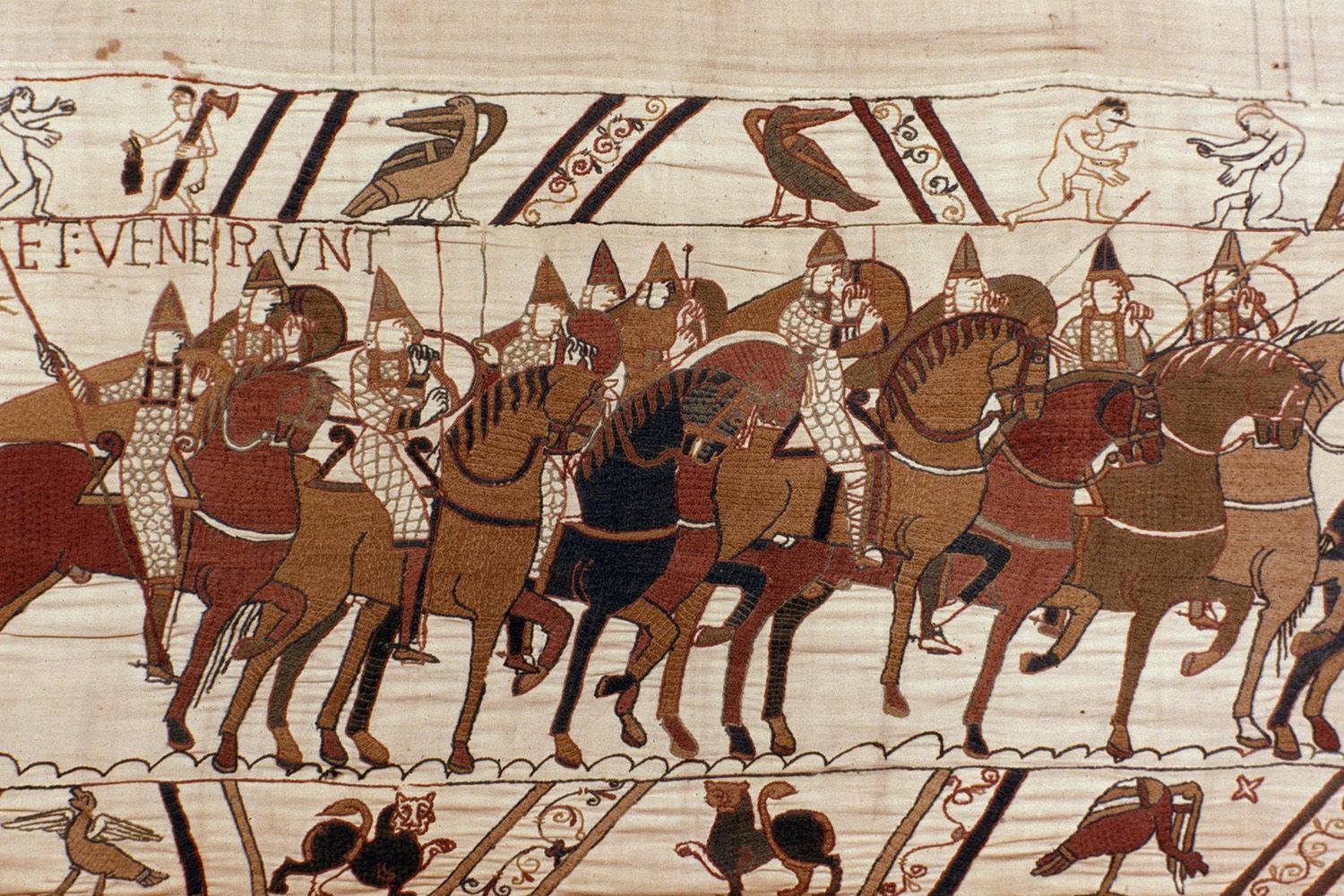
The Norman army in battle
Is the Bayeux Tapestry English, Norman, French or something in between? The recent media discussion regarding this 60-metre long, 50cm-high work of embroidery – made in the late 11th century to commemorate the Conquest of England by William the Conqueror, whose various campaigns it depicts – has repeatedly emphasised a belief that it was made in England. As such, its possible loan to an as-yet unknown museum in the United Kingdom in 2022 has been presented as something of a ‘homecoming’. Yet the evidence regarding the Tapestry’s 950-year history suggests that, from its inception and throughout its existence, the Tapestry has embodied a rich tradition of cross-cultural meaning and exchange.
Made in England?
The Tapestry’s link to Bayeux probably dates to its inception. Strong evidence suggests that it was commissioned by William’s half-brother, Bishop Odo of Bayeux, though others have been suggested, including William’s queen, Matilda, Count Eustace of Boulogne and even William himself.
The case for Odo is threefold. First, with the exception of William and Harold, Odo appears more times (four) than any other individual in the Tapestry and is shown in leading roles: ordering the construction of a fleet (we know from written sources that he gave substantial sums to this enterprise); blessing a meal; advising William on the campaign; and, lastly, fighting during the battle at Hastings. Second, the Tapestry locates Harold’s oath to uphold William’s claim to the English throne at Odo’s church in Bayeux, even though written sources variously claim that it took place at Bonneville-sur-Toques and Rouen. Third, the Tapestry names three otherwise unknown and apparently marginal figures: Wadard, Vital and Turold. Documents related to Odo’s finances record that he had tenants with all three names, suggesting that the bishop had commemorated his friends in the narrative.
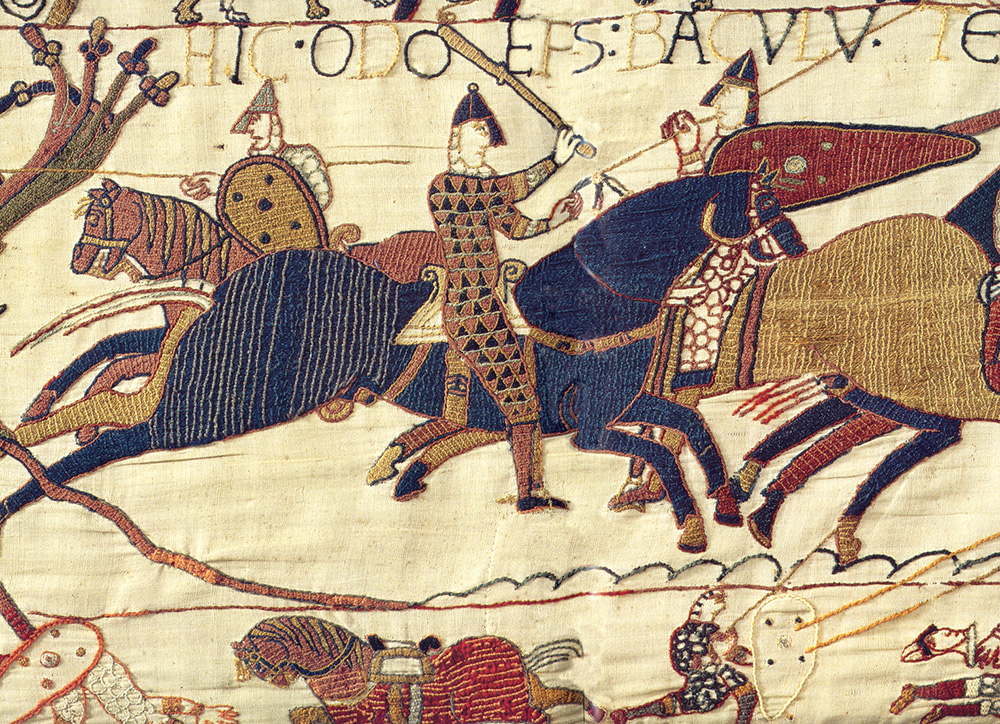
There can be little doubt that the Tapestry represents a pro-Norman justification of the Conquest. Its narrative asserts that Harold promised to uphold William’s claim to England and swore an oath of allegiance on sacred relics in Normandy before taking the crown for himself after the death of Edward the Confessor. This left William with little choice but to invade England and punish Harold as an oath-breaker.
Yet despite its pro-Norman narrative, there is far stronger evidence for the Tapestry having been made in England than in Normandy. England had a strong tradition of commemorative and high-quality needlework, as recorded by the conquest chronicler, William of Poitiers, the 12th-century history of Ely known as the Liber Eliensis, and descriptions of English-made embroidery gifted to the Abbey of La Trinité in Caen in the will of Queen Matilda. There is no evidence for equivalent traditions in Normandy at this time.
Similarly, there is a strong tradition of pictorial narratives in some of the best works of pre-Conquest English manuscript art. These include the ‘Old English Hexateuch’ manuscript (a copy of the first six books of the Bible from St Augustine’s Abbey in Canterbury, which features over 400 narrative scenes) and numerous later 11th-century manuscripts of English origin, which contain elaborately decorated narrative scenes. No such traditions feature in Norman manuscript art before the 12th century and after that only developed probably due to exchanges with England.
Finally, there is the fact that the English variant spellings featured within the Tapestry, including GYRÐ (Harold’s brother), ÆLFGYVA (unknown), CEASTRA (for ‘castra’) and EADWARD (for Edward) could only have been known by English-speaking designers and embroiderers.
While this evidence does not prove that the Tapestry was made in England, it certainly makes an English origin more likely than a Norman one.
Wilderness Years
The Tapestry must have been completed before Bishop Odo was exiled by his brother, William, in 1082, apparently following a disagreement over the bishop’s planned expedition to Italy to proclaim himself as pope. It is tempting to imagine what Odo did with his Tapestry and how it was received by William. There may have been some kind of grand public unveiling and its contents must surely have been well received by William and his fellow Normans.
We know that the Tapestry must have been accessible before 1102, when a Norman poet, Baudry of Bourgueil, described it by imagining that it had been kept in the bedroom of William’s daughter, Adela. While this fanciful description was probably intended to flatter Adela, with whom Baudry hoped to win favour, this story does reveal that he had at least seen the Tapestry, although when and where cannot be known.
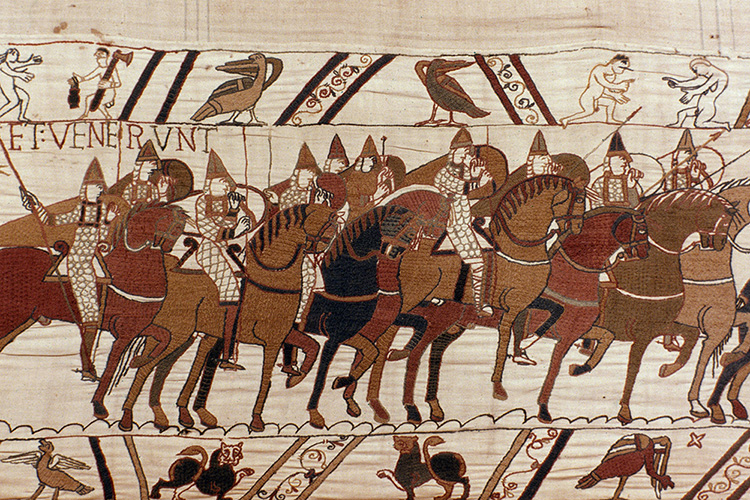
Aside from this, we simply have no evidence for the Tapestry’s journey until the later Middle Ages. By the end of the 14th century, it belonged to successive kings of France and was kept in Paris. In 1396, 35 Parisian sous (a few weeks’ work for a skilled artisan) were paid from the royal accounts to one Jehan de Jaudoigner, so that he might repair ‘a grand tapestry on the conquest of England’. Similar references follow on from this. In 1422, during the Hundred Years War, Henry V of England drew up an inventory of goods owned by Charles VI of France after a series of victories had brought France to its knees. Included in this list is a ‘grand tapestry of high quality, named the “Duke William, who conquered England”’. The same item was mentioned in another inventory, this time for Henry VI, dated to 1432. Later in the 1430s, a list recording the possessions of Phillip the Good, Duke of Burgundy, an ally of the English, described
a large, good quality tapestry, without gold, the history of Duke William of Normandy, how he conquered England.
The Tapestry had returned to Bayeux by 1476, when it was described in an inventory of the town’s cathedral church, as:
a very long and narrow hanging of linen, embroidered with figures and inscriptions representing the Norman conquest of England, and which is hung around the nave of the church on the Feast of Relics.
We cannot know under what circumstances the Bayeux Tapestry made these successive moves. What is known, however, is the ‘rediscovery’ of the Tapestry as an item of historical significance after the end of the Middle Ages and its reception by later audiences.
While we can be certain that the population of Bayeux knew of the Tapestry during the centuries which followed 1476, it only came to wider prominence from the beginning of the 18th century. Nicholas-Joseph Foucault, Intendant for Normandy between 1689 and 1704, was impressed enough to commission a hand-drawn transcription, completed up to the point at which William rescues Harold from Count Guy. This drawing of what was then an apparently little known artefact drew the attention of a succession of antiquaries, including Antione Lancelot (1675-1740) and Bernard de Montfaucon (1655-1741). Their work resulted in numerous published drawings and engravings of the Tapestry and a variety of (usually fairly critical) commentaries on its place in art history, as well as comparisons of its content with the surviving written sources for the Norman Conquest.
English scholars were also interested in the Tapestry. William Stukeley (1687-1765) recognised its significance for English history and attempted to appropriate the object for England by describing it as the ‘noblest monument of English antiquity abroad’. By contrast, in 1738 the decidedly unimpressed English traveller John Breval described the Tapestry as a ‘most barbarous piece of needlework’.
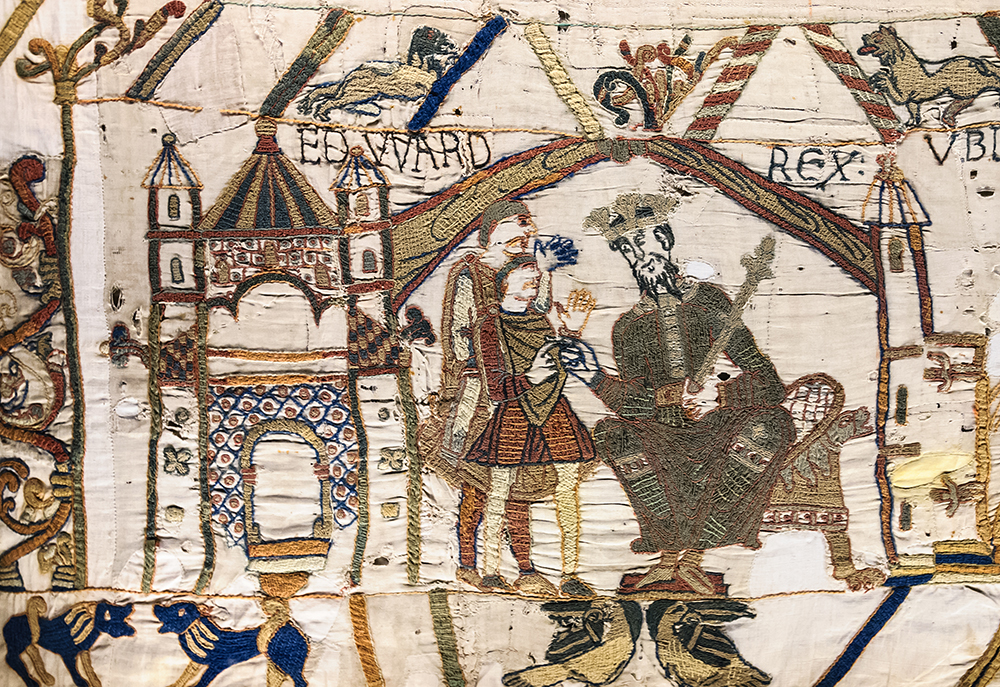
Varying names were given to the Tapestry in this period by both English and French scholars, including the Toile de St-Jean (‘canvas of St John’, due to its regular display in Bayeux on the Feast of St John), Toilette du Duc Guillaume (toilette meaning a small canvas), Tapisserie de Guillaume le Conquérant and the Tapestry of Queen Maud (Matilda). Almost every commentator recorded the local tradition attributing the Tapestry to Queen Matilda, a theory of origin which persisted until the mid-20th century.
Rise to Fame
The survival of the Tapestry was threatened at various points in its later history. In 1562 during a period of fierce religious conflict, a Protestant mob stormed the cathedral at Bayeux during Mass, ransacking the building and its treasures. The Tapestry probably survived because it was locked away in storage.
One of the best-known episodes in the Tapestry’s story was recorded in an 1840 report by a local administrator, a Monsieur Pezet, in preparation for an exhibition. Pezet recounted how, in 1792, the sixth Calvados Battalion attempted to use the Tapestry as cover for a requisitioned wagon, until police commissioner Lambert-Léonard Le Forestier recognised the significance of the object and issued a recovery order in exchange for a more suitable canvas wagon cover. The Tapestry was kept in Le Forestier’s office and remained in the administration buildings for some time.
Another story dates to 1803 when Napoleon Bonaparte used its conquering narrative to promote his preparations to invade Britain. Between November 1803 and February 1804, the Tapestry was displayed at the Musée Napoléon in Paris and viewed by the First Consul himself in a private viewing. The exhibition was accompanied by an official guidebook and was widely reported by the French press, ensuring that the Tapestry came into greater public prominence than ever before.
Returning to Bayeux shortly after the exhibition, the Tapestry was retained in public ownership within municipal buildings. In 1814 the English traveller Hudson Gurney reported that it was kept ‘coiled round a machine, like that which lets down the buckets to a well’. In 1842 it was moved to a more suitable location, behind an eye-level glass case in a purpose-built exhibition space, named the Galerie Mathilde after its purported maker, in the municipal library of Bayeux. It remained there for 70 years, moving only once for safe-keeping in 1870, during the Franco-Prussian war. During this period, it was also repaired and re-lined.
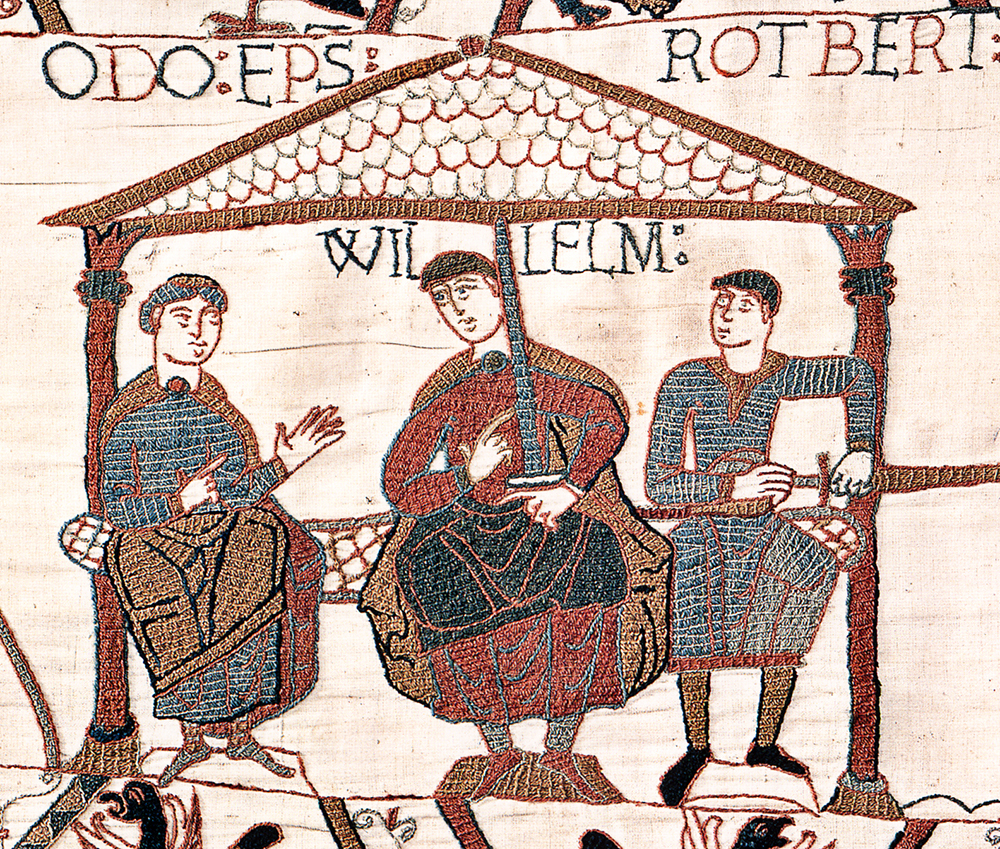
In the 1870s, the Tapestry was subject to renewed English interest, when the South Kensington (now Victoria and Albert) Museum requested permission to photograph the entire Tapestry for display and dissemination of reproductions outside Bayeux. Multiple copies of the resulting photographs were made and sent to England, Denmark and the US. In 1931 the organisers of an exhibition on French art in London requested permission to borrow the Tapestry. A barrage of protest followed, with emphasis on the potential damage to the tourist economy of Bayeux and to the Tapestry itself. The request was eventually rejected.
Life During Wartime
In 1938 plans were put in place for the preservation of the Tapestry in the event of war. In recognition of its importance, a purpose-built concrete shelter was placed below the Hôtel du Doyen in Bayeux, in which the Tapestry was placed inside a zinc-lined wooden crate, rolled on a winder. During the German occupation, the Ahnenerbe branch of the SS (specialising in academic studies) identified the artefact as evidence of early Germanic culture and subjected it to numerous studies. The Tapestry was displayed, photographed and examined, moved to the Abbey of Saint-Martin at Mondaye (11km from Bayeux) and then the Château at Sourches in 1943 (175km from Bayeux). Experts working on the project were to contribute to a book on the artefact and Dr Herbert Jankuhn, an archaeologist from Kiel, even gave a talk on the Tapestry to Heinrich Himmler, the Head of the SS, in Berlin.
After the allied invasion in June 1944, the Tapestry was again moved for safekeeping to Paris, where it was stored in the cellars of the Louvre. General Deitrich von Choltitz later recounted how Himmler had ordered its preservation in late August, but by this time the Louvre was occupied by French Resistance fighters. The Tapestry was displayed at the Louvre in late 1944 and returned to Bayeux in March 1945, where it was decided to construct a new purpose-built display in the Hôtel du Doyen, completed on 6 June 1948.
Further requests were made to borrow the Tapestry after the war, including by the Victoria and Albert Museum in 1953, which asserted that an object made by Queen Matilda would make a fitting contribution to events surrounding the coronation of Elizabeth II. Sir Leigh Ashton, Director of the V&A, claimed that his idea had the support of French ambassadorial staff and promised to give the entire net revenue of the proposed London exhibition to the Bayeux museum. Although the proposal was accepted in Bayeux, the French Monuments Historique board expressed concern and the exhibition was eventually cancelled.
Homecoming?
The Bayeux Tapestry has been subject to immense public and academic interest in the decades since the Second World War. Situated in a purpose-build exhibition space within a former seminary since 1983, the Tapestry is now kept in climate and light-controlled conditions. Its size and its unique ability to be understood simply by being looked at means that it continues to achieve its aim of communicating its story to large audiences of varying previous knowledge. The museum attracts almost 400,000 visitors a year, with audio guides available in 16 languages. In 2007 the Tapestry was registered by UNESCO as a ‘Memory of the World’ artefact.
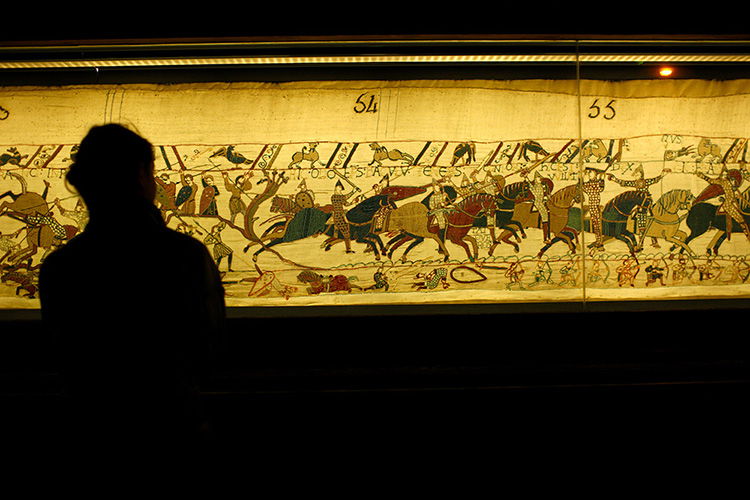
In many ways, displaying the Bayeux Tapestry in the UK makes sense. It depicts the Conquest of England and was probably designed and made by English hands. When we reflect on the making, design and later reception of the Tapestry, it becomes less a symbol of boundaries and more of a monument to a shared past.
Although it was probably commissioned by the Norman Bishop Odo with propagandist purposes in mind, the narrative of the Tapestry is not wholly one-sided. Harold is presented as more of a tragic hero than an arch villain, initially shown as a friend of William and fighting for him, even saving Norman soldiers from the mud of the River Couesnon, before ultimately falling prey to his own ambitions.
This blend of English origins, a decidedly Norman story and successive claims by later audiences to have inherited the history it portrays, made the Tapestry a subject of fascination for late medieval kings, and also the first antiquarian students and interpreters of its contents. Its rich significance has been recognised by scholars, rulers and, we can also assume, the innumerable ‘ordinary’ persons who have viewed and formulated their own understandings of the Tapestry, over its roughly 950-year existence. If the Tapestry does travel to Britain in 2022 it will give historians the chance to raise awareness of the complexities of identity apparent within its production, reception and use over the centuries.
Charlie Rozier is Lecturer in Medieval History at Swansea University.